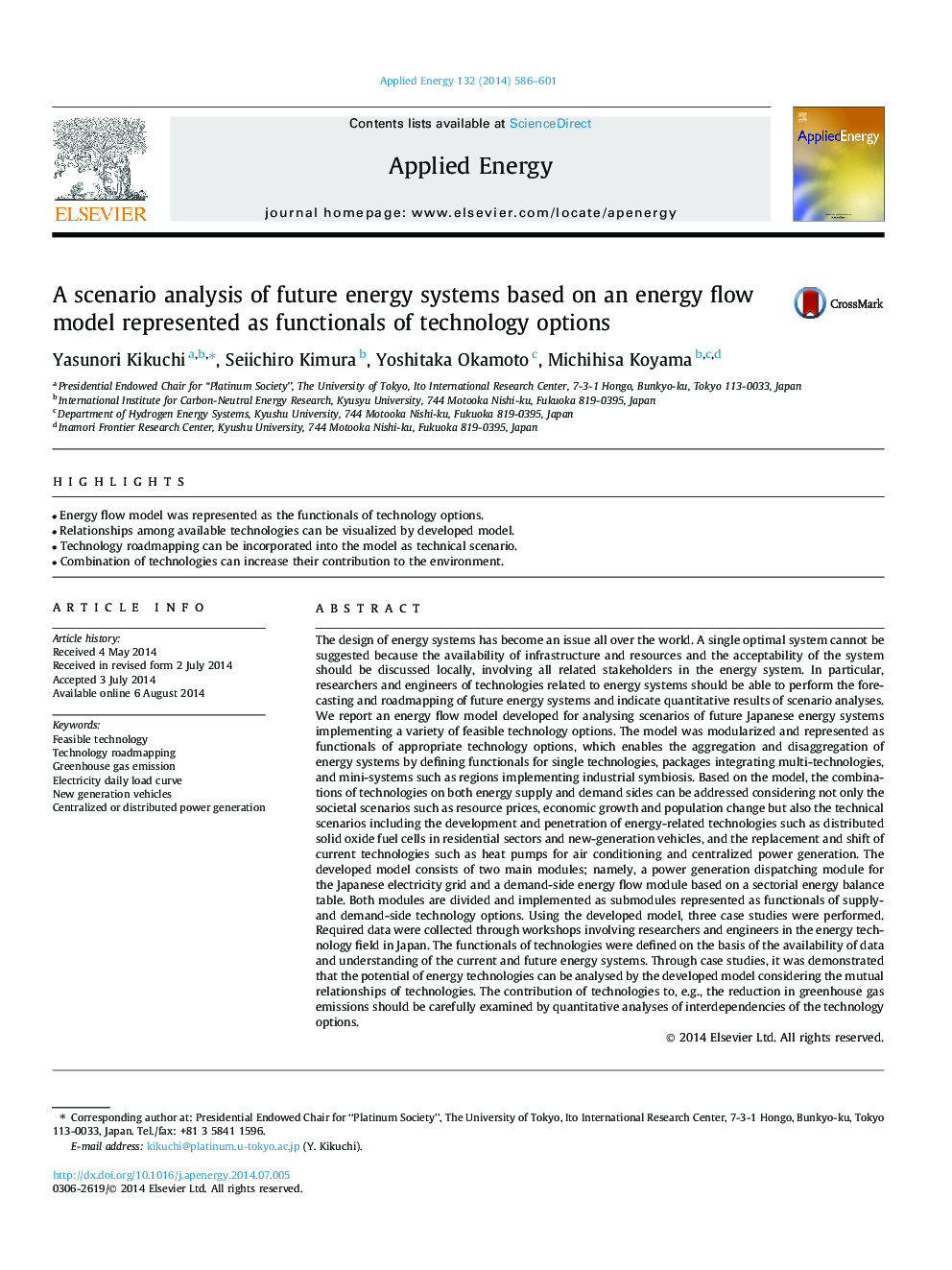| کد مقاله | کد نشریه | سال انتشار | مقاله انگلیسی | نسخه تمام متن |
|---|---|---|---|---|
| 6689930 | 501892 | 2014 | 16 صفحه PDF | دانلود رایگان |
عنوان انگلیسی مقاله ISI
A scenario analysis of future energy systems based on an energy flow model represented as functionals of technology options
ترجمه فارسی عنوان
تجزیه و تحلیل سناریو سیستم های انرژی آینده بر اساس یک مدل جریان انرژی نشان داده شده به عنوان کارکردهای گزینه های تکنولوژی
دانلود مقاله + سفارش ترجمه
دانلود مقاله ISI انگلیسی
رایگان برای ایرانیان
کلمات کلیدی
تکنولوژی امکان پذیر، نقشه راه فناوری، انتشار گازهای گلخانه ای، برق منحنی بار روزانه، وسایل نقلیه جدید، تولید برق متمرکز یا توزیع شده،
ترجمه چکیده
طراحی سیستم های انرژی در سراسر جهان تبدیل شده است. یک سیستم بهینه مطلوب نمی تواند پیشنهاد شود چرا که در دسترس بودن زیرساخت ها و منابع و پذیرش سیستم باید در سطح محلی مورد بحث قرار گیرد، شامل تمام سهامداران مرتبط در سیستم انرژی. به طور خاص، محققان و مهندسین فن آوری های مربوط به سیستم های انرژی باید قادر به انجام پیش بینی و نقشه برداری از سیستم های انرژی آینده باشند و نتایج کمی از تحلیل های سناریو را نشان دهند. ما یک مدل جریان انرژی را برای تجزیه و تحلیل سناریوهای سیستم های انرژی آینده ژاپن که انواع گزینه های تکنولوژی امکان پذیر است، ارائه می دهیم. این مدل مدولاسیون شده و به عنوان کارکردهای گزینه های فن آوری مناسب مطرح شده است، که امکان جمع آوری و تقسیم سیستم های انرژی را با تعریف عملکرد برای فن آوری های تک، بسته های یکپارچه سازی چند تکنولوژی و مینی سیستم هایی مانند مناطقی که از همکاری های صنعتی استفاده می کنند، امکان پذیر می سازد. بر اساس مدل، ترکیبی از فناوری ها در هر دو طرف عرضه و تقاضای انرژی می تواند با توجه به نه تنها سناریو های اجتماعی مانند قیمت منابع، رشد اقتصادی و تغییر جمعیت، بلکه سناریوهای فنی شامل توسعه و نفوذ فن آوری های مرتبط با انرژی مانند سلول های سوخت جامد اکسید جامد در بخش های مسکونی و وسایل نقلیه نسل جدید، و جایگزینی و تغییر فن آوری های جاری مانند پمپ های حرارتی برای تهویه مطبوع و تولید برق متمرکز. مدل توسعه یافته شامل دو ماژول اصلی می باشد. یعنی یک ماژول اعلان تولید برق برای شبکه برق ژاپن و یک ماژول جریان انرژی در سمت تقاضا بر اساس یک جدول تعادل انرژی بخش. هر دو ماژول تقسیم شده و به عنوان زیرموایل اجرا می شوند که به عنوان عملکردی از گزینه های تکنولوژی عرضه و تقاضا ارائه می شوند. با استفاده از مدل توسعه یافته، سه مورد مطالعه انجام شد. داده های مورد نیاز از طریق کارگاه های آموزشی شامل محققان و مهندسان در زمینه فناوری انرژی در ژاپن جمع آوری شد. کارکرد فن آوری ها براساس دسترسی داده ها و درک سیستم های فعلی و آینده انرژی تعریف شده است. از طریق مطالعات موردی، نشان داده شد که پتانسیل فن آوری های انرژی را می توان با استفاده از مدل توسعه یافته با توجه به روابط متقابل فن آوری ها مورد تجزیه و تحلیل قرار داد. سهم فن آوری ها، به عنوان مثال کاهش انتشار گازهای گلخانه ای، باید با تحلیل کمی از وابستگی های متفاوتی از گزینه های تکنولوژی، به خوبی مورد بررسی قرار گیرد.
موضوعات مرتبط
مهندسی و علوم پایه
مهندسی انرژی
مهندسی انرژی و فناوری های برق
چکیده انگلیسی
The design of energy systems has become an issue all over the world. A single optimal system cannot be suggested because the availability of infrastructure and resources and the acceptability of the system should be discussed locally, involving all related stakeholders in the energy system. In particular, researchers and engineers of technologies related to energy systems should be able to perform the forecasting and roadmapping of future energy systems and indicate quantitative results of scenario analyses. We report an energy flow model developed for analysing scenarios of future Japanese energy systems implementing a variety of feasible technology options. The model was modularized and represented as functionals of appropriate technology options, which enables the aggregation and disaggregation of energy systems by defining functionals for single technologies, packages integrating multi-technologies, and mini-systems such as regions implementing industrial symbiosis. Based on the model, the combinations of technologies on both energy supply and demand sides can be addressed considering not only the societal scenarios such as resource prices, economic growth and population change but also the technical scenarios including the development and penetration of energy-related technologies such as distributed solid oxide fuel cells in residential sectors and new-generation vehicles, and the replacement and shift of current technologies such as heat pumps for air conditioning and centralized power generation. The developed model consists of two main modules; namely, a power generation dispatching module for the Japanese electricity grid and a demand-side energy flow module based on a sectorial energy balance table. Both modules are divided and implemented as submodules represented as functionals of supply- and demand-side technology options. Using the developed model, three case studies were performed. Required data were collected through workshops involving researchers and engineers in the energy technology field in Japan. The functionals of technologies were defined on the basis of the availability of data and understanding of the current and future energy systems. Through case studies, it was demonstrated that the potential of energy technologies can be analysed by the developed model considering the mutual relationships of technologies. The contribution of technologies to, e.g., the reduction in greenhouse gas emissions should be carefully examined by quantitative analyses of interdependencies of the technology options.
ناشر
Database: Elsevier - ScienceDirect (ساینس دایرکت)
Journal: Applied Energy - Volume 132, 1 November 2014, Pages 586-601
Journal: Applied Energy - Volume 132, 1 November 2014, Pages 586-601
نویسندگان
Yasunori Kikuchi, Seiichiro Kimura, Yoshitaka Okamoto, Michihisa Koyama,
